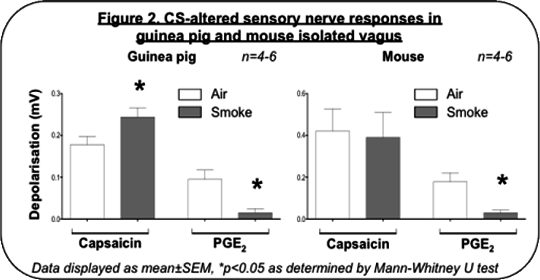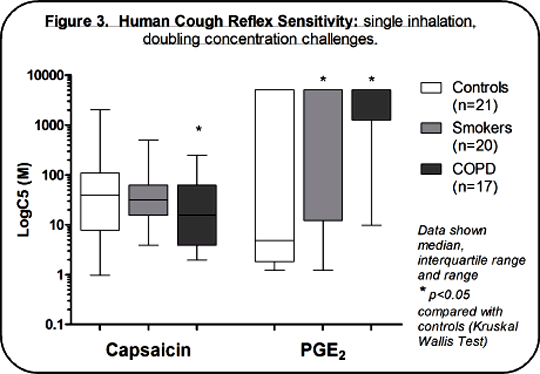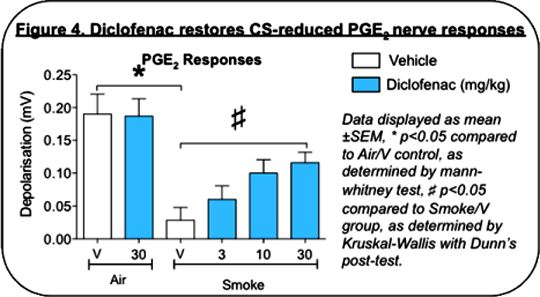Print version
Search Pub Med
P064 Cough And Vagal Sensory Afferent Responses To PGE2 Are Altered In A Guinea Pig Cigarette Smoke Exposure Model And In Human Smokers And COPD Patients Compared To Normal Volunteers Incidence of Chronic Obstructive Pulmonary Disease (COPD) – an inflammatory lung disease associated with cigarette smoke (CS) exposure – is increasing worldwide, with no effective medications available. Cough is an essential defence reflex; however in inflammatory diseases excessive coughing is a debilitating symptom, for which COPD patients frequently seek medical care (Chung 2011). Previous clinical studies found increased cough reflex sensitivity to capsaicin in smokers and COPD patients (Blanc 2009; Doherty 2000; Wong 1999), whilst separate studies show increased levels of endogenous inflammatory & pro-tussive agents, e.g. PGE2 (Montuschi 2003). Our hypothesis is that in COPD, altered expression/activity of key GPCRs and ion channels drive changes in sensory nerve responsiveness, and thus the cough reflex. We investigated how CS-exposure altered cough/sensory nerve responses in animal models, compared with human smokers/COPD patients. Male Dunkin-Hartley guinea pigs (300-350g) or C57Bl/6 mice (20-25g) were exposed to CS (3R4F Kentucky Research Cigarettes) twice daily for 8 days, as described by Eltom (2011). Diclofenac (3-30mg/kg) or vehicle (5% ethanol in saline) was dosed 3xdaily, 1h before 1st, 1h after 2nd, and once at mid-point of CS-exposures. Cough or vagus experiments were performed 24h post CS-exposure. Cough, evoked by 5min aerosolised capsaicin (30μM, 1% ethanol, 1% tween 80 in saline), or PGE2 (0.1mg/ml, 0.1M phosphate buffer), was recorded over 10 or 15min respectively, as described in Belvisi (2008). Depolarisation of isolated vagus nerve – described in Belvisi (2008) – induced by incubation with capsaicin (1μM) or PGE2 (10μM) for 2min (both 0.01% DMSO in Krebs-Henseleit solution). Cough reflex sensitivity, in human subjects recruited at Manchester University Hospital, was determined as the concentration of capsaicin or PGE2 (0.1-1M in physiological saline) to evoke 5 coughs (C5) – as in Young (2009). .gif) 
In CS-exposed guinea pigs, capsaicin (TRPV1 agonist) evoked more coughs, whereas PGE2 (via the EP3 receptor) evoked far fewer (Figure 1). In sensory nerves from CS-exposed guinea pigs/mice, capsaicin-depolarisation was greater in guinea pigs, and PGE2-responses were abrogated in both species (Figure 2). Human cough responses in smoker and COPD patients were similarly altered (Figure 3). To investigate the mechanism of altered PGE2 responses, we postulated that CS-exposure increased endogenous prostanoid production, decreasing PGE2-induced responses possibly by desensitisation or internalisation of the EP3 receptor. Consistent with this hypothesis, a non-selective COX inhibitor (diclofenac) dose-dependently restored PGE2 responses (Figure 4), indicating the CS-induced change depends on endogenous prostanoid release induced by CS-exposure. Our findings in pre-clinical models, corroborated by a translational clinical cough study, begin to provide a better understanding of how the cough reflex to endogenous agents is modulated in disease. Such knowledge is key to informing future clinical trial design, and aiding development of safe and effective novel anti-tussive medications.  
References: Belvisi, Patel, Freund-Michel et al., 2008. BJP Blanc, Macedo, Hew et al., 2009. Resp. Med. Chung, 2011. Pulm Pharmacol & Ther. Doherty, Mister, Pearson et al., 2000. Thorax. Eltom, Stevenson, Rastrick et al., 2011. PloS one. Montuschi, Kharitonov, Ciabattoni et al., 2003. Thorax. Wong & Morice, 1999. Thorax. Young, Brammer, Owen et al., 2009. Thorax.
|
|

